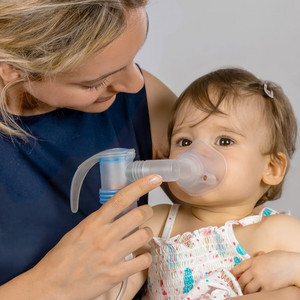Sniffles, coughs and colds – newborn infants and toddlers are often sick. Paediatrician Dr Manfred Praun explains why, at what point you should take your little one to the doctor and what you can do against infections.

Dr Praun: Infants initially have a relatively low susceptibility to infections because they have “passive immunity”, passed on from their mother. In the last trimester of pregnancy, the material antibodies arising from infections or vaccinations the mother has had pass through the placenta into the child’s circulation. That largely protects the young infants from infections in the first three months of their life. As soon as this passive protection from the mother wears off, however, the risk of viral and bacterial infection rises.
When toddlers are taken to mother-baby groups and daycare, this activates their immune system early on, triggering it to defend against a wide range of pathogens and to develop antibodies. For this reason, toddlers constantly catch airway infections after they start nursery school/daycare, which fortunately are usually harmless. Nonetheless, an infection can go from one thing to another and give parents the feeling that their child is never actually properly well.
There are also physiological reasons why it is harder for young children to fight off infections than it is for adults. A toddler’s ribs are arranged much more horizontally and the chest is much more elastic, which weakens the effect of the force of breathing from the muscles located between the ribs. This means that the chest cannot expand as much when they breath in, and so less air flows into the lungs.
Then if the lower airways become infected, the bronchial mucous membranes swell. This means that the child has to breathe harder, which results in the often-observed paradoxical chest movements – when the child breathes in, the chest compresses and you can see their tummy and ribs sucking in.
Dr Praun: It is not rare for a toddler to have up to ten infections a year, especially if they attend day care or a nursery school. These infections frequently affect the upper airways and are often harmless. However, in infants, even mild infections are significant as they prefer to breathe through their nose, which is why even “trivial” sniffles can sometimes cause considerable problems. It is much harder for the child to breastfeed and so affects their dietary intake.
The most common infections are caused by rhinoviruses (over 100 different types are known), RSV (respiratory syncytial virus), metapneumoviruses and influenza viruses. Bacterial infections are rarely the cause. Especially in winter, the RS and influenza viruses are the most prevalent and can cause especially severe symptoms. RS viruses are highly infectious and lead to at least one infection in almost all toddlers by their second birthday. As even after an infection there is no lasting immunity, children can contract these diseases multiple times.
Dr Praun: Experience shows that toddlers in particular who are looked after in nursery school or daycare in their first year will have more frequent infections. The earlier the children are infected by their older siblings who are already at a community facility, the earlier the start of frequent infections is in these younger age groups.
Experience also shows that children who are prone to chronic ventilation disorders of the nose and paranasal sinuses (small ethmoidal cells in the nose) due to upper respiratory tract infections get sick particularly often. The reason is relatively simple. The impaired nose breathing means that the function of the nose (filtering, warming and moistening the air) is put out of action. Mouth breathing allows a host of particles and bioaerosols (such as viruses and bacteria) to be breathed into the lower airways unfiltered and leads to more frequent coughs and involvement of the bronchial tubes. This is why these children in particular benefit from inhalation therapy.

Dr Praun: Parents should take their child to the doctor with the following symptoms:
Cough with shortness of breath and whistling, grunting sounds. It should be noted that breathing rate, which varies according to age, can also indicate lung disease. As soon as shortness of breath is evident – either by the chest sucking in or paradoxical breathing or an increased rate of breathing – patients must be examined, regardless of their age.
If a toddler or infant has signs of shortness of breath it is often a viral infection (such as RSV, influenza or rhinoviruses) and should not be treated with antibiotics, even if they have a fever. Bacterial infections caused by streptococci, pneumococci and other bacteria are to be distinguished from viral infections by detailed diagnostic testing and should be treated with targeted therapy.
Dr Praun: If a child has unusual infections when they are young, such as pneumonia, meningitis or severe middle ear infections, an impaired immune system must be considered.
The basic testing is initially easy and simply involves testing the immunoglobulins (A, G, M and E) along with blood panel and a test that counts the various types of white blood cells. If the findings are outside the normal ranges, there are specialist departments on-hand in hospitals.
Dr Praun: Every infection takes rest and time to recover. That is the most important rule! A healthy diet, plenty of fluids and regular fresh air can aid a faster recovery. Especially if the child has an airway infection, nurturing the airways by inhalation therapy with isotonic saline solution (0.9%) is especially recommended.

Dr Praun: The nebulisation of saline solution (isotonic or three-percent saline solution) can play a supportive role in the treatment of airway infections. Moistening the airways with saline nebulisation using a nebuliser can be especially helpful when the generally sensitive mucous membranes in the airways of toddlers are irritated by infections, allergies or dry air.
By moistening the airways, the secretions can become more liquid, making them easier to cough up and reducing the urge to cough. This removes mucus and other deposits from the airways. Well-moistened mucous membranes improve sleep quality and the child can recover more quickly from an infection. Hypertonic saline solution has a stronger effect at mobilising mucus and can shorten hospital stays for viral bronchiolitis as well as relieve breath sounds and coughing.
For toddlers, the wide range of saline solutions are a very well-tolerated treatment option. If the parents are instructed accordingly, it may make sense to start inhalation therapy with saline solution using a nebuliser at the first signs of infection in their child.
Remember: The parents should, however, always consult a doctor if the child has a serious infection of the airways or if symptoms persist.
Dr Praun: In addition to standard good hygiene practices, a balanced diet, adequate sleep, a smoke-free environment and avoiding contact with anyone who is infected – which is not always possible with siblings and in everyday life – it is important to keep the mucous membranes in the child’s airways moist. Inhaling saline with a nebuliser can really help.
A clinical study has even shown that healthy adults breathe out fewer bioaerosols, i.e. viruses and bacteria, after an inhalation treatment with isotonic saline solution. Further tests are, however, required for even clearer confirmation of this effect.
At the moment we have the opportunity to protect toddlers by passive immunisation with monoclonal antibodies in their first RSV season or to offer pregnant women a vaccination. But there are many pathogens, such as rhinoviruses which trigger symptoms of a cold, against which the child’s body has to make their own antibodies to be protected from these pathogens in the future.
Dr Manfred Praun works in his practice PREVIMED in Gilching as a registered, independent specialist for paediatric and adolescent medicine. His goal: Not only to see children and adolescents through illnesses, but also to ensure that they develop into healthy, strong and confident adults. In his YouTube channel Doc Praun, he gives valuable advice on the health of babies, children and adolescents.
Note: The information in this blog post is not a treatment recommendation. The needs of patients vary greatly from person to person. The treatment approaches presented should be viewed only as examples. PARI recommends that patients always consult with their physician or physiotherapist first.
An article written by the PARI BLOG editorial team.
© 2025 PARI GmbH Spezialisten für effektive Inhalation